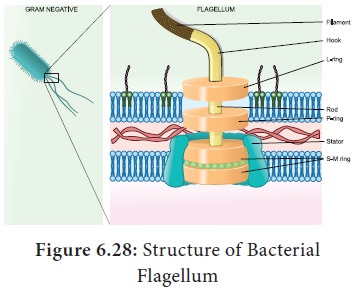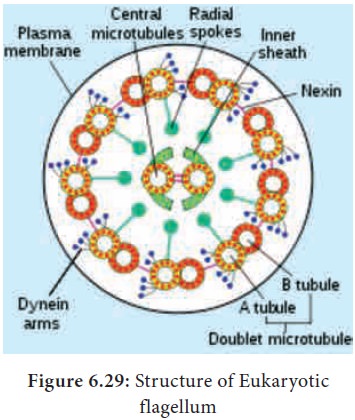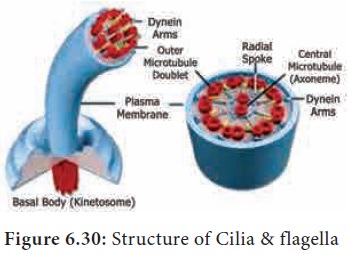Types, Structure, Movement - Flagella | 11th Botany : Chapter 6 : Cell: The Unit of Life
Chapter: 11th Botany : Chapter 6 : Cell: The Unit of Life
Flagella
Flagella
1. Prokaryotic Flagellum

Bacterial flagella are helical
appendages helps in motility. They are much thinner than flagella or cilia of
eukaryotes. The filament contains a protein called flagellin. The structure consists of a basal body associated with cytoplasmic membrane and cell wall with
short hook and helical filament. Bacteria rotates their helical flagella and
propels rings present in the basal body which are involved in the rotary motor
that spins the flagellum.
Structure of flagella in Bacteria
![]()
![]()
![]()
The gram positive bacteria contain only two basal
rings. S-ring is attached to the inside of peptidoglycan and M-ring is attached
to the cell membrane. In Gram negative bacteria two pairs of rings proximal and
distal ring are connected by a central rod. They are L-Lipopolysaccharide ring
P-Peptidoglycan ring, S-Super membrane ring and M-membrane ring. The outer pair
L and P rings is attached to cell wall and the inner pair S and M rings
attached to cell membrane (Figure 6.28).
Check your grasp ?
When E-coli are cultured in medium rich in glucose they lack flagella. When grown in nutritionally poor medium they possess flagella. What does this indicate about the value of flagella?
Flagella is essential to seek out a nutritionally more favourable environment.
Mechanism of flagellar movement – proton motive force
In flagellar rotation only proton
movements are involved and not ATP. Protons flowing back into the cell through
the basal body rings of each flagellum drives it to rotate. These rings
constitute the rotary motor. The proton motive force (The force derived from
the electrical potential and the hydrogen ion gradient across the cytoplasmic
membrane) drives the flagellar motor. For the rotation of flagellum the energy
is derived from proton gradient across the plasma membrane generated by
oxidative phosphorylation. In bacteria flagellar motor is located in the plasma
membrane where the oxidative phosphorylation takes place. Therefore, plasma
membrane is a site of generation of proton motive force.
2. Eukaryotic Flagellum– Cell Motility
Structure
Eukaryotic Flagella are enclosed by unit membrane and it arises from a basal body.
Flagella is composed of outer
nine pairs of microtubules with two microtubules in its centre (9+2
arrangement). Flagella are microtubule projection of the plasma membrane.
Flagellum is longer than cilium (as long as 200µm). The structure of flagellum
has an axoneme made up microtubules and protein tubulin (Figure 6.29).
Movement
Outer microtubule doublet is
associated with axonemal dynein which generates force for movement. The movement
is ATP driven. The interaction between tubulin and dynein is the mechanism for
the contraction of cilia and flagella. Dynein molecules uses energy from ATP to
shift the adjacent microtubules. This movement bends the cilium or flagellum.

3. Cilia
Cilia (plural) are short
cellular, numerous microtubule bound projections of plasma membrane. Cilium
(singular) is membrane bound structure made up of basal body, rootlets, basal
plate and shaft. The shaft or axoneme
consists of nine pairs of microtubule doublets, arranged in a circle along the
periphery with a two central tubules, (9+2)
arrangement of microtubules is present. Microtubules are made up of tubulin.
The motor protein dynein connects
the outer microtubule pair and links
them to the central pair. Nexin links the peripheral doublets of microtubules
(Figure 6.30).

Related Topics